Although we spent an entire week during the month of September taking a virtual tour around Nashville Symphony’s new $123.5 million Schermerhorn Symphony Center, we didn’t quite get all the way through. As such, it is high time to resume the final two articles in this series. This installment will continue by examining the SSC’s multitude of lobby and patron facilities…
Feeling Comfortable In Your Surroundings

Although the concert hall should always be the top priority when designing a building like this, that doesn’t mean you cut corners when planning public space. I’ve been pleased with the trend over the past several years among architects to move away from the gilded opulence of yesteryear and move toward more inviting, inclusive concert hall designs.
In Nashville’s, case, it’s as though they have managed to strike a fair balance between the two. There’s no doubt that the Neo-Classical inspired design (pictured to your left) harkens back to a timeless age but there are plenty of tell-tale signs that this isn’t a simple recycling of building designs from a bygone age. In fact, principal architect, David M. Schwarz, was happy to point out those aspects.
“It’s not a neo-classical building,” said David. “It’s neo-classical inspired building, just look at all of those windows.”
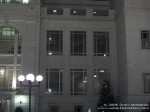
And if you take the time to look at the front of the building, you will indeed find walls of windows. In the photograph to your left, you can see an example of the windows that flank each side of the columned entrance. These windows in particular illuminate the main lobby staircase on the east side of the building.

 Another neo-classical inspired element is the frequent use of marble, as demonstrated in the photograph to your far left. This particular pattern is from the floor of the west lobby entrance. During one of the press tours, the building manager pointed out that they went to great lengths to make sure that the use of so many hard surface materials didn’t create public spaces that were too loud. I would say that they were successful about 70% of the time. The only locations I noticed where sound from voices was overpowering were in the west lobby, pictured to your near left, which is located adjacent to the café alcove. Regardless, the lobby spaces are all visually stunning.
Another neo-classical inspired element is the frequent use of marble, as demonstrated in the photograph to your far left. This particular pattern is from the floor of the west lobby entrance. During one of the press tours, the building manager pointed out that they went to great lengths to make sure that the use of so many hard surface materials didn’t create public spaces that were too loud. I would say that they were successful about 70% of the time. The only locations I noticed where sound from voices was overpowering were in the west lobby, pictured to your near left, which is located adjacent to the café alcove. Regardless, the lobby spaces are all visually stunning.
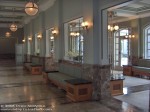
 Speaking of the café, the symphony plans to serve a variety of meals on a regular basis prior to most regularly scheduled concert series events as well as certain rental events. The café space is situated between the outside courtyard (which will feature outdoor seating when weather permits, the ticket office, and the west lobby. Among all the public spaces, I though this one was inspired more by Art Deco than Neo-Classical. However, the space is still connected to the rest of the building through the use of color as well as an identical wood inlay for the bar front. I was particularly fond of the variation on the Viennese lighting fixtures found throughout the building (pictured to your left). Can you see the piano key motif they designed into the bar front using wood inlay (pictured to your near left)?
Speaking of the café, the symphony plans to serve a variety of meals on a regular basis prior to most regularly scheduled concert series events as well as certain rental events. The café space is situated between the outside courtyard (which will feature outdoor seating when weather permits, the ticket office, and the west lobby. Among all the public spaces, I though this one was inspired more by Art Deco than Neo-Classical. However, the space is still connected to the rest of the building through the use of color as well as an identical wood inlay for the bar front. I was particularly fond of the variation on the Viennese lighting fixtures found throughout the building (pictured to your left). Can you see the piano key motif they designed into the bar front using wood inlay (pictured to your near left)?
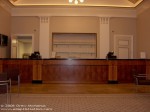
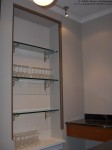 You don’t have to spend much time walking around the Schermerhorn Symphony Center to realize that this place has quite a few bars, the largest of which is pictured to your far left. They all have the same piano key front motif and the music ornamentation doesn’t stop there. If you take a close look at the brackets that hold up the glass shelves, you’ll notice that they are treble clefs turned at a 90 degree angle, as the photograph to your near left illustrates.
You don’t have to spend much time walking around the Schermerhorn Symphony Center to realize that this place has quite a few bars, the largest of which is pictured to your far left. They all have the same piano key front motif and the music ornamentation doesn’t stop there. If you take a close look at the brackets that hold up the glass shelves, you’ll notice that they are treble clefs turned at a 90 degree angle, as the photograph to your near left illustrates.
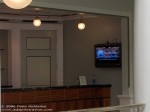
 Another distinct feature throughout the hall is the inclusion of more than a dozen flat screen televisions. Each screen can provide a closed circuit signal of what’s going on in the concert hall or just about anything else the organization decides to transmit. The photograph to your far left shows one of the medium size screens that are present at nearly every bar. However, not every feature inside the new building is unique as the designers took a page from Bass Hall in Fort Worth and included a number of video screens set behind a dark glass mirror, one of which is pictured to near left.
Another distinct feature throughout the hall is the inclusion of more than a dozen flat screen televisions. Each screen can provide a closed circuit signal of what’s going on in the concert hall or just about anything else the organization decides to transmit. The photograph to your far left shows one of the medium size screens that are present at nearly every bar. However, not every feature inside the new building is unique as the designers took a page from Bass Hall in Fort Worth and included a number of video screens set behind a dark glass mirror, one of which is pictured to near left.
 Personally, I was glad to see that the designers didn’t forget to include a large number of seats throughout all of the lobbies. You’ll find everything from simple padded benches, pictured to your far left, to surprisingly comfortable chairs and sofas. One of the most appealing spaces in the entire hall is located at the very top level. As Nashville Symphony President & CEO, Alan Valentine, explained during a press tour, the “cheap seats” actually boast one of the most inviting, comfortable lobby spaces in the entire building.
Personally, I was glad to see that the designers didn’t forget to include a large number of seats throughout all of the lobbies. You’ll find everything from simple padded benches, pictured to your far left, to surprisingly comfortable chairs and sofas. One of the most appealing spaces in the entire hall is located at the very top level. As Nashville Symphony President & CEO, Alan Valentine, explained during a press tour, the “cheap seats” actually boast one of the most inviting, comfortable lobby spaces in the entire building.
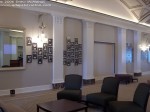
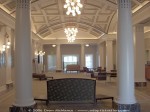
 In addition to having it’s own bar, restrooms, and coat rooms, this lobby also features photographs of every musician artfully arranged along the entire north wall, as pictured to your far left. The lobby, pictured to your middle left, maintains an open, bright feel during the day and offers an equally attractive very in the evening. However, one of the most striking features is the domed ceiling, which is pictured in the photograph to your near left. I found this to be such an inviting space that I stopped to eat my lunch here on the day I was going around taking pictures.
In addition to having it’s own bar, restrooms, and coat rooms, this lobby also features photographs of every musician artfully arranged along the entire north wall, as pictured to your far left. The lobby, pictured to your middle left, maintains an open, bright feel during the day and offers an equally attractive very in the evening. However, one of the most striking features is the domed ceiling, which is pictured in the photograph to your near left. I found this to be such an inviting space that I stopped to eat my lunch here on the day I was going around taking pictures.
If you spend enough time in any one place, you’ll eventually need to use a bathroom. Women will be pleased to know that there is twice the number of restrooms for women as there are for men. However, that doesn’t mean men’s restrooms are hard to come by; for example, I never found myself having to wait to use a bathroom, even on the evening of the Gala. And although I may be alone in this interest, I always like to judge a building by how much effort they put into designing the bathrooms.

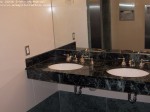 More often than not, the interior of bathrooms are dull and uninspired. Nevertheless, it’s still a space people have to look at so why not make it interesting. I was pleasantly surprised to discover that the architects didn’t phone it in when they designed the bathrooms. They all have the same green marble motif, pictured in the two photographs to your left.
More often than not, the interior of bathrooms are dull and uninspired. Nevertheless, it’s still a space people have to look at so why not make it interesting. I was pleasantly surprised to discover that the architects didn’t phone it in when they designed the bathrooms. They all have the same green marble motif, pictured in the two photographs to your left.
 However, you’ll find yourself smiling when you look up to see that the border along the top of the walls has a music staff etched into the tile along with names of famous composers; and not just the dead ones. At the same time, I don’t want to know how they decided which composer goes where in the sequence. The photograph to your left illustrates that there’s no bias toward traditional composers.
However, you’ll find yourself smiling when you look up to see that the border along the top of the walls has a music staff etched into the tile along with names of famous composers; and not just the dead ones. At the same time, I don’t want to know how they decided which composer goes where in the sequence. The photograph to your left illustrates that there’s no bias toward traditional composers.
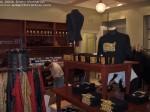 Finally, with an appropriate nod to merchandising, one of the last public spaces is the Symphony Center gift shop where patrons can purchase the expected assortment of orchestra related merchandise, including the orchestra’s recordings. And as you can see in the photograph to your left, the Kenneth Schermerhorn bobble head dolls are still available; get yours now before they’re gone.
Finally, with an appropriate nod to merchandising, one of the last public spaces is the Symphony Center gift shop where patrons can purchase the expected assortment of orchestra related merchandise, including the orchestra’s recordings. And as you can see in the photograph to your left, the Kenneth Schermerhorn bobble head dolls are still available; get yours now before they’re gone.
You Can’t Get There From Here
The only aspect of the building I found myself grumbling about was the fact that it’s easy to get lost. With only a few exceptions, numerous aspects of the interior look very much alike. Combine that with the fact that the building’s three levels are actually divided into six half levels and you’ll quickly discover that you might want to bring a GPS with you to prevent getting lost.
The only aspect of the building I found myself grumbling about was the fact that it’s easy to get lost. With only a few exceptions, numerous aspects of the interior look very much alike. Combine that with the fact that the building’s three levels are actually divided into six half levels and you’ll quickly discover that you might want to bring a GPS with you to prevent getting lost.
According to David Schwarz, the multi-level design was selected because it allowed them to comply with ADA directives in the best possible way. Nevertheless, the labeling of each level isn’t exactly intuitive and even after spending more than 16 hours in the building I often found myself having to ask for directions to get from one point to another. In fact, one of the areas the organization will need to improve is how well ushers and volunteers are prepared to give directions.
In fact, I think they need to abandon verbal instructions as much as possible and actually have employees walk patrons to their destination. Case in point, during my first evening in Nashville, I attended a preview concert. In an attempt to pick up my ticket at will-call (the automated ticketing kiosks were not functional yet) I asked an usher where I could find the box office. She gave me detailed instructions which I attempted to follow until I realized I wasn’t getting anywhere. So I stopped to ask another usher, who gave me a new set of instructions.
After going through this process with two more ushers I actually ended up face to face with the first user again. At first, I thought it must just be me but then I started watching patrons and it didn’t take long to determine that my experience wasn’t unique. For elderly patrons, all of the unnecessary walking was not a pleasant experience and a few of them were complaining heavily to their fellow concertgoers.
Add to that a distinct lack of clear signage pointing patrons in the directions of bathrooms (which never seemed to be intuitively located in my opinion) and elevators and you end up feeling a bit like you’re in a well appointed hedge maze. If you’re going to the hall for the first time and you’re with a group, I strongly suggest that everyone bring their cell phone. At least you can play a game of cellular Marco Polo to help find each other if you get separated.
Fortunately, the solution to the above problems is simple: improve usher and volunteer training to include walking patrons to destination points and increase the amount of signage. It would also be a good idea to throw in a few “you are here” signs using the nifty 3-D sketches they have of each floor. Additionally, including some maps in the program books and having ushers mention them when distributing the books would be a good idea too.
I have to way that at least one of the SSC staff understands this problem already. During the Gala evening, I was having a terrible time trying to find a particular room and after asking seven different ushers and volunteers for directions (all of which ended up fruitless) I bumped into the head waiter, who I met at an earlier function the day before. I asked him for directions and without missing a beat, he put down the tray of empty drink glasses he was carrying and cheerfully walked me to where I needed to go.
Unfortunately, I lost the page of paper I used to write down his name but I would recommend that the SSC executives use this individual as the go-to guy when training ushers and volunteers with assisting patrons.
Come back tomorrow for part 6 where we’ll take a look around the donor’s lounge, board room, green room, and finally get a good look inside the concert hall.


